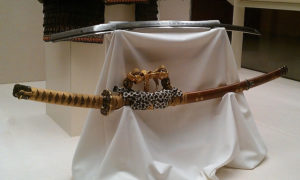by Jack El-Hai, Wonders & Marvels contributor
By 1956, James Stannard, a plumber in North Dorset, Vermont, had suffered as much guilt as he could stand. As a U.S. Army lieutenant in occupied Japan during the months after World War II, his job had been to disarm civilians. On one occasion, he seized a fifteenth-century sword, crafted by the famed weapon maker Kanemitsu, that had been passed from one generation to the next within a Japanese family.

An ornate samurai sword in the collection of the British Museum. Photo by Andres Rueda, via Wikimedia Commons.
Members of the family were distraught. “They offered me a wad of yen, and that must have been a couple of thousand dollars, but I had my orders,” Stannard said. “I took the sword. As I was leaving their house in Nagoya, they begged me to treat it well. They told me to use nothing but vegetable oil on the sharp gleaming blade. When we were allowed to bring back a souvenir, I chose the sword to remind me of Japan. But it always reminded me of the man who begged that it be returned someday.”
Years passed and Stannard’s guilt grew. Aware that Northwest Airlines had a large operation in Japan, he asked the airline for help in finding the sword’s true owner. And Northwest succeeded in tracking down 59-year-old Isao Okuda of Nagoya. With Stannard’s consent, the company worked out a plan to return the sword, which was three and a half feet long and sheathed in sharkskin, to Okuda. Northwest employees took charge of the voluminous customs and police paperwork necessary to restore the sword to its nation of origin.
“The sword, tempered and still gleaming, was delivered in New York to stewardess Carole Kilander of St. Paul on today’s flight,” Ed Wallace of the New York World-Telegram and Sun wrote on January 16, 1957. “Miss Kilander will take the sword to Seattle and give it to another stewardess who will carry it on to Anchorage, Alaska. There it will be given to a third Northwest Orient air stewardess who will take it to Tokyo.”
Paul Bencoster, a Northwest staffer in Japan, met the plane and took part at the exit ramp in the reunion of the sword with its owner. “Captain Moore turned the sword over to myself, and I in turn handed it over to Mr. Fujiyama, representative of the Japanese government, who in turn turned it over to its original owner,” Bencoster wrote.
A few minutes later, in a press conference inside the airport, a swarm of reporters and cameramen watched the kimono-clad Okuda accept the sword a second time. “He then, with the sword in his hand, expressed his heartfelt appreciation to Northwest Airlines and finally shook hands with me for about five minutes, making a speech all the while, most of which I did not understand,” Bencoster noted, “but I presume he was again thanking me for the part NWA had played in the return of his family’s heirloom.”
Guilt assuaged.
This post is excerpted and adapted from Non-Stop: A Turbulent History of Northwest Airlines by Jack El-Hai, published by the University of Minnesota Press.
Further reading
Anderson, Jim. “Across years, across miles, sword returning home.” Minneapolis Star Tribune, September 21, 2013.
Turnbull, Stephen. Katana: The Samurai Sword. Osprey Publishing, 2012.
